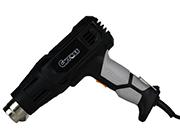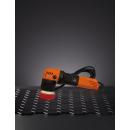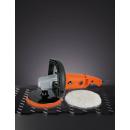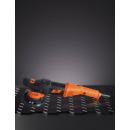Electric body polisher

Electric body polisher for cars
-
 8500.0075Orbital polishereccentric 15mm diam 75mm
8500.0075Orbital polishereccentric 15mm diam 75mm -
 8600.0175Electric polisher1200 W - 1000 to 3300 rpm
8600.0175Electric polisher1200 W - 1000 to 3300 rpm -
 8650.0015Orbital polishereccentric 15mm diam 125mm
8650.0015Orbital polishereccentric 15mm diam 125mm
︾
Electric bodywork polisher for your car or motorbike repairs:
Electric bodywork polishers are essential tools in the field of vehicle repair and cosmetic maintenance. They are used to polish and shine the exterior surface of vehicles, remove paint imperfections and restore optimum shine. Here are some important features and considerations for electric body polishers:
1. Types of electric body polishers :
Rotary polishers :
These polishers make a rotating motion and are generally used for heavier paint correction tasks. They can be powerful but require a certain amount of skill to avoid damaging the paintwork.
Orbital polishers :
Orbital polishers perform eccentric orbital movements, making them more user-friendly for novice users. They are often recommended for finish polishing and removing small imperfections.
2. Motor power :
The power of the polisher's motor is measured in watts. Higher power can result in faster, more efficient polishing, particularly for paint correction tasks.
3. Adjustable speed:
The best polishers offer an adjustable speed. This allows the user to adjust the speed to suit the type of work, the material and the desired result. Adjusting the speed is crucial to avoiding damage to the paint and achieving optimum results.
4. Orbital or rotary movement :
The choice between orbital and rotary movement depends on the user's level of experience and the type of work. Orbital movements are often safer for beginners and are suitable for buffing and polishing tasks.
5. Polishing pads :
Polishing pads, usually made of foam, are used with the polisher to apply polishing products to the body surface. They are available in different densities for varying results.
6. Dust extraction system :
Some models of electric polishers are equipped with dust extraction systems to maintain a clean working environment.
7. Ergonomics and weight:
A lightweight, ergonomic polisher is easier to manoeuvre for long periods, reducing user fatigue.
8. Protection against overheating :
Some models incorporate overheat protection mechanisms to prevent damage to the motor during prolonged use.
9. Safe polishing :
Using the right combination of polishing products, pads and technique is crucial to achieving safe polishing results and avoiding damage to the paint.
In summary, the choice of an electric bodywork polisher depends on the user's level of experience, the type of work to be carried out and the desired results. It is advisable to follow the manufacturer's recommendations and practise on less visible areas before applying the polisher to larger surfaces.
Technical differences between corded and battery electric polishers:
The main differences between corded and battery-operated electric body polishers lie in power supply, mobility and operating time. Here's an overview of the distinctive features of each type:
Corded electric body polisher :
Continuous power supply :
Corded polishers are powered continuously by an electrical source. They offer constant power without interruption, which can be advantageous for longer jobs.
Consistent power:
Being connected to an electrical source, corded polishers can deliver consistent power, which is important for more demanding polishing tasks, such as correcting paintwork.
No low battery problems:
Users don't have to worry about the battery draining, which can be an advantage during extended projects.
Power cable:
The presence of a power cable limits mobility and can sometimes be restrictive, particularly in confined spaces.
Battery-operated electric body polisher:
Mobility and freedom of movement:
Battery-powered polishers offer greater freedom of movement because they are not tied to a fixed power source. This makes them ideal for outdoor work or in areas where access to an electrical socket is limited.
Fewer bulky cables:
The absence of power cables can simplify work, reduce the risk of tangling and make it easier to navigate around the vehicle.
Versatility of use:
Battery-powered polishers are often more versatile in terms of mobility, which can be advantageous for varied tasks or large vehicles.
Limited autonomy:
Operating time is limited by battery capacity. Depending on the size of the battery and the intensity of use, it may be necessary to recharge the battery during prolonged use.
Potentially lower power :
In some cases, battery-powered polishers may have slightly less power than corded models, although technological advances have significantly improved battery performance.
Note:
Battery technology is evolving rapidly, and today's battery polishers can rival their corded counterparts in terms of performance, offering sufficient power for many automotive polishing jobs.
Ultimately, the choice between a corded and battery polisher depends on the user's preferences, the type of work to be carried out, and the flexibility required on site. Each has its advantages, and the best choice depends on the user's specific needs.
FAQ : Everything you need to know about electric body polishers :
How do I choose the right electric polisher for my bodywork?
The choice depends on the task in hand. For general polishing, an orbital polisher may be more user-friendly. If heavier corrections are needed, a rotary polisher may be appropriate. Also consider the power, adjustable speed and suction system for optimum results.
How can I avoid the risk of over-polishing or damaging the paintwork?
Use appropriate polishing pads and follow the manufacturer's recommendations for speed and pressure. Work in small sections, monitor the process carefully and adjust if necessary. Practical training can also reinforce skills to avoid mistakes.
How often should I polish my bodywork?
The frequency depends on various factors such as exposure to the elements, wash cycles and road conditions. As a general rule, a yearly polish can maintain the shine of the bodywork. However, adapt the frequency to your vehicle's specific needs.
What polishes and pads should I use to get the best results?
Compatibility between the polish, the pad and the paint is essential. Choose quality products, and make sure that the pad matches the task (foam for buffing, microfibre for polishing). Test a small area first.
Can an electric polisher remove deep scratches on my bodywork?
For deep scratches, a polisher can improve the appearance, but it may not completely remove the marks. For deep scratches, consult a bodywork professional for advice on appropriate repair methods.
Can I use my electric polisher to apply wax?
An electric polisher is not the ideal tool for applying wax. Use appropriate wax applicators instead. A polisher is designed for buffing and polishing, whereas applying wax requires a more precise manual approach.
What's the best way to maintain my electric polisher?
Clean the pads and backing plates regularly. Follow the manufacturer's instructions for motor maintenance. Lubricate moving parts as recommended. Make sure the polisher is stored in a dry, clean place.
Does using an electric polisher require any specific training?
Although most users can learn the basics, specific training can improve mastery of advanced techniques. Online tutorials, demonstration workshops, or even automotive detailing courses can be useful in honing your skills.
In conclusion, using an electric body polisher requires a considered approach and a thorough understanding to achieve optimum results. Ask questions, test on less visible areas, and don't hesitate to seek professional advice to maximise the benefits of this essential vehicle maintenance tool.